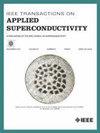超导全桥电流驱动逆变器的基本实验
IF 1.7
3区 物理与天体物理
Q3 ENGINEERING, ELECTRICAL & ELECTRONIC
引用次数: 0
摘要
超导体具有高度非线性的电流电压曲线,已被广泛应用于各种领域,例如故障电流限制器、磁通泵和持久模式磁铁。人们已经知道,超导体的动态电阻可以在外部磁场的作用下开关。本文应用了这一知识,并首次演示了全桥逆变器的实验,该逆变器使用由外部磁场触发的高温超导体动态电阻作为开关元件。针对基本实验装置,研究了磁场、频率和超导体特性对逆变器行为的影响。结果,实验证明了利用超导体动态电阻并在短路输出条件下工作的全桥电流驱动逆变器的原理。实验表明,在考虑短路运行的情况下,换向时间可缩短至 5 毫秒,而通过增加暴露在磁场中的超导体长度,还可进一步缩短换向时间。长达 120 秒的长时间运行也已实现。通过进一步增加超导体的长度,可以实现更快的换向时间和更高的电压。本文章由计算机程序翻译,如有差异,请以英文原文为准。
Basic Experiments With a Superconducting Full-Bridge Current-Driven Inverter
Superconductors have a highly nonlinear current voltage curve that is already used in various applications, such as, for example, in fault current limiters, flux pumps, and persistent mode magnets. It is already known that the dynamic resistance of superconductors can be switched on and off with external magnetic fields. This article applies this knowledge and demonstrates for the first-time experiments with a full-bridge inverter that uses the dynamic resistance of high-temperature superconductors triggered by external magnetic fields as switching elements. For a basic experimental setup, the influence of magnetic field, frequency, and superconductor properties on the behavior of the inverter was investigated. As a result, the principle of a full-bridge current-driven inverter using the dynamic resistance of superconductors and operating in short-circuit output condition is experimentally demonstrated. It is shown that, with reference to the considered short-circuit operation, commutation times down to 5 ms were achieved and that a further reduction is possible by increasing the superconductor length that is exposed to magnetic fields. Long operation times of up to 120 s have been achieved. An upscaling towards faster switching times and higher voltages are possible by further increasing superconductor length.
求助全文
通过发布文献求助,成功后即可免费获取论文全文。
去求助
来源期刊

IEEE Transactions on Applied Superconductivity
工程技术-工程:电子与电气
CiteScore
3.50
自引率
33.30%
发文量
650
审稿时长
2.3 months
期刊介绍:
IEEE Transactions on Applied Superconductivity (TAS) contains articles on the applications of superconductivity and other relevant technology. Electronic applications include analog and digital circuits employing thin films and active devices such as Josephson junctions. Large scale applications include magnets for power applications such as motors and generators, for magnetic resonance, for accelerators, and cable applications such as power transmission.
 求助内容:
求助内容: 应助结果提醒方式:
应助结果提醒方式:


